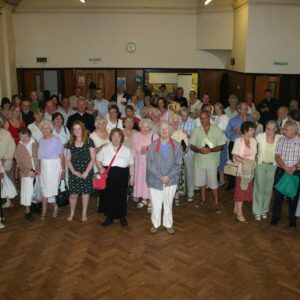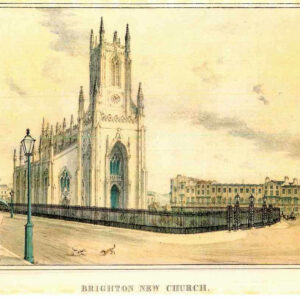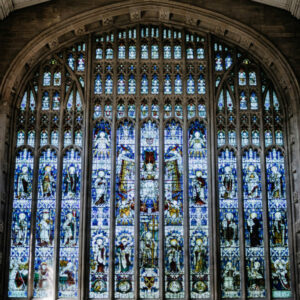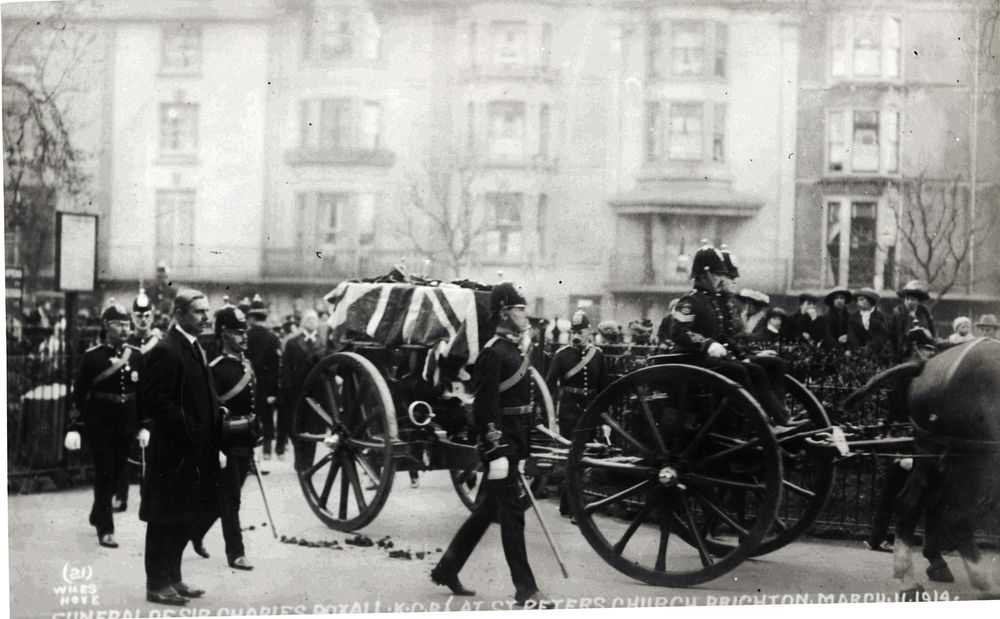Prominent People
Over the past 200 years, visitors to St Peter’s include many, many well-known individuals, not least among them Princess Augusta, sister to King George IV, who was present when the church opened in January 1828, and King Charles, when he was the Prince of Wales.
But central to the life of the church has always been its clergy. We’ve listed below in chronological order, those leaders who have guided the congregation since the church opened in 1828.
Vicars of St Peter’s: a timeline
Information supplied by Paul Nicholl in his book A History of St Peter’s Church, Brighton
Thomas Cooke
Born in 1791, Rev Thomas Cooke was a military chaplain before he arrived at St Nicholas’ church as a curate a year before St Peter’s opened. At that time, St Nicholas’ Church was the parish church of Brighton. Cooke served as ‘Perpetual Curate’ at St Peter’s for more than 40 years, retiring in 1872. He was the church’s longest serving vicar. St Peter’s became the parish church of Brighton a year later, and Cooke died a year after that, in 1874.
John Hannah
Ordained in 1841, Rev John Hannah arrived in Brighton in 1870 from Perthshire. Under his leadership, with the Bishop of Chichester Richard Durnford, Hannah split St Nicholas’ and St Peter’s into separate parishes and St Peter’s became the parish church of Brighton. Hannah became Vicar of Brighton at St Peter’s from 1872, and his son John Julius Hannah took over at St Nicholas’. Hannah became archdeacon of Lewes in 1876, the same year he founded the Pelham Institute in Kemptown to cater to the social and spiritual needs of the growing working-class population of east Brighton. He resigned as Vicar of Brighton in 1887 and died a year later aged 69.
John Julius Hannah
Rev John Julius Hannah (1845-1931) took over from his father as Vicar at St Peter’s in 1887. During his tenure, he oversaw work on the lady chapel and the beginning of construction of new chancel. A memorial to Hannah’s son killed in 1899 during the Boer War in South Africa sits on the west side of the new chancel. The extension was completed in 1906, four years after Hannah had left to become Dean of Chichester. He retired in 1929 and died in 1931.
Benedict Hoskyns
Born in 1856 and ordained in 1880, Benedict Hoskyns became Vicar of Brighton at St Peter’s in 1902. He oversaw the completion of the chancel with its beautiful north window dedicated to Queen Victoria. The window was designed by Charles Kempe and includes a portrait of the queen, who had died in 1901, in the corner.
The chancel was consecrated on 29 June 1906 by the Bishop of Chichester, in the presence of the Archbishop of Canterbury, Randall Davidson, who gave the sermon at a service to mark the occasion. The installation of a pipe organ followed in 1910 in memory of King Edward VII, a frequent visitor to Brighton. In 1914, John Richman donated 10 bells to replace the tower’s eight.
Having become archdeacon of Hastings in 1915, Hoskyns resigned as Vicar of Brighton in 1917, became archdeacon of Chichester in 1920 and retired in 1934. He died in 1935.
Francis Dormer Pierce
Francis Pierce served as Vicar of Brighton at St Peter’s for five years, arriving from Essex where he was vicar of Prittlewell, Rural Dean of Southend and Honorary Canon of Chelmsford Cathedral. At St Peter’s, he oversaw work begin on the memorial hall to the dead of the First World War. He died of heart failure on 2 December 1923, on his way to the morning service.
Frederick Hicks
Dr Frederick Hicks Became Vicar of Brighton in 1924. Born in 1872 and ordained in 1897, he served at St Peter’s for just three years from 1924 before being appointed Bishop of Gibraltar in 1927. One of his first acts as bishop was to dedicate the memorial hall at St Peter’s, paid for with funds collected from the public between 1921-27, to those killed in the First World War. The hall’s stained-glass window features images of St Peter and St Wilfred and an inscription in memory of Rev Pierce. Hicks went on to become Bishop of Lincoln in 1932 and died in 1942.
Alfred Rose
Rev Rose arrived at St Peter’s in 1927, serving eight years as Vicar of Brighton before he was appointed Bishop of Dover in 1935. Born in 1884, he had been a naval chaplain during the WWI, Vicar of Haigh in Greater Manchester and warden of the Bishop’s Hostel in Lincoln before arriving in Brighton. He retired in 1957, and died in 1971, aged 86.
John How
John How, born in 1881 and ordained in 1906, was Rural Dean of Liverpool before taking up his role at St Peter’s. He was Vicar of Brighton for just three years before he left to become Bishop of Glasgow and Galloway. He had been offered the role of Bishop of Brisbane, Australia, but turned it down. In 1946, he was elected Primus of Scotland, retired in 1952 and died in 1961 in Hove.
Geoffrey Hodgson Warde
Arriving at St Peter’s in 1939, Geoffrey Warde served as Vicar of Brighton throughout the Second World War. He was born in 1889, ordained in 1915 and had served as an army chaplain during WWI. In a previous role as Dean of Gibraltar, he had worked under Federick Hicks. He left in 1945 to become Archdeacon of Carlisle before being appointed Bishop of Lewes in 1946, where he remained until he retired in 1959. He died in Hove in 1972.
Frederick Robathan
Frederick Robathan was born in Gorakhpur, India, in 1896. Before he arrived in Brighton in 1945, he was a Minor Canon at St Paul’s Cathedral from 1928-1933 and Westminster Abbey from 1934-1937, before becoming Vicar of St John’s Hackney. He also served as Chaplain to the Forces. During his tenure, the church was listed at a Grade II building. He left St Peter’s to become Canon of Ely from 1953-1959 and died in 1986, aged 90.
David Booth
David Booth was born in 1907 and served as Chaplain to the Royal Naval Volunteer Reserve during WW2, before becoming Rector of Stepney in 1945. He arrived at St Peter’s in 1953, leaving six years later to become Archdeacon of Lewes. In 1972, he was appointed Headmaster of Shoreham College. He also served as Canon and Prebendary at Chichester Cathedral until he retired in 1977. He died in 1993.
John Keeling
John Keeling, born in 1907, succeeded Booth as Vicar of Brighton in 1960. Since 1937, Keeling had served as a Royal Air Force Chaplain, including postings in the Middle East, Bomber Command, Germany, Home Command and as Chaplain to the Queen (1957-1960). During his time at St Peter’s, which ended in 1974, he oversaw the decoration of the chancel ceiling (1967-1969).
John Hester
John Hester was vicar at St Peter’s for ten years from 1975. During his tenure, he was patron to a number of struggling local parishes and appointed rural dean of Brighton, Kemp Town and Preston. He also took on the chaplaincy of Brighton & Hove Football Club, which he retained until he retired from his position as canon residentiary of Chichester Cathedral in1997.
Dominic Walker
Dominic Walker took over from John Hester in 1985, arriving from St Mary’s, Newington. He was appointed Team Rector, Vicar and Rural Dean of Brighton and a Canon & Prebendary of Chichester Cathedral. Not long into his tenure, the carved reredos behind the alter were destroyed by an arson attack, prompting the reorganisation of the front of the church. Walker left St Peter’s in 1997 to become Bishop of Reading before he was appointed Bishop of Monmouth in 2003. He retired in 2013.
Douglas McKittrick
Born in 1953, Douglas McKittrick became Vicar of Brighton in 1997 and rural Dean of Brighton in 1998 after serving as Team Vicar of St Luke in the City, Liverpool (1981-1989) and Vicar of Toxteth Park (1989-1997). During another appeal in 1999 to raise funds for repairs, King Charles, then Prince of Wales, visited St Peter’s and was very supportive of the restoration project. In 2002 he was appointed Archdeacon of Chichester.
David Biggs
David Biggs had been Vicar at the Chapel Royal since 1999 when he was appointed priest-in-charge at St Peter’s in 2002. Intended to be in post for one year, he remained for seven, which included some of the most turbulent times for the church. Facing mounting repair costs, in 2007, St Peter’s was slated for closure. A congregation-led campaign pushed to save the church. A decision was made to split patronage of the church between the Bishop of Chichester and the Vicar of Holy Trinity Brompton in London, while The Church Renewal Trust signed a 125-year lease on the building. The last service under the old structure was held on 29 June 2009. Biggs left St Peter’s but continued as Vicar at Chapel Royal until he retired in October 2023.
Archie Coates
Archie Coates was an associate vicar at Holy Trinity Brompton before leading its first church plant to revitalise St Peter’s. He moved to Brighton from London with his wife Sam and their young family and around 50 others called to help breathe new life into the congregation and restore the building. Under his leadership, St Peter’s became a busy, vibrant church once more. Coates returned to HTB as Vicar in 2022.
Dan Millest
The Millest family arrived in Brighton in 2022 from Kuala Lumpur, where Dan served as an associate vicar at HTB Bukit Bintang.

St Peter’s is Saved
Maureen Dickson shares her memories and journey of being part of the church, her son's wedding, and also with the the Friends of St Peter’s to save the church.

The Fight to Save the Church
In 2007, St Peter’s faced imminent closure. The church building had fallen into expensive disrepair, and the congregation had dwindled. However, thanks to a group of committed church members who campaigned to keep its doors open, St Peter's entered a new phase under new leadership.

At the Heart of the City
Sitting at the heart of Brighton, the evolution of St Peter's has mapped the city's transformation from a fishing village to a busy, cosmopolitan, creative hub. Take a tour of the timeline of St Peter's, from initial plans to build a church on this spot to celebrations 200 years later of its vibrant church community.

Windows, Organ and Font
Visitors to the church often note its cathedral dimensions, highlighted by glorious stained-glass windows. Notable among them are work by Victorian designer Charles Eamer Kempe.

Through the Wars
The church has been a source of hope and strength in wartime.

Building for the Future
Stuart Christie, buildings and facilities manager at St Peter's Brighton, describes what it takes to look after our 200-year old building to ensure it's fit for purpose for centuries to come.






‘This project is kindly funded by Historic England as part of the Everyday Heritage - Working Class Histories. We are grateful to them for this funding.’